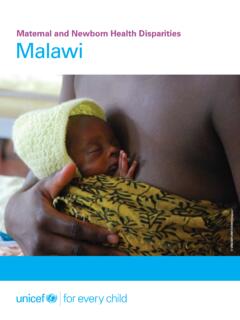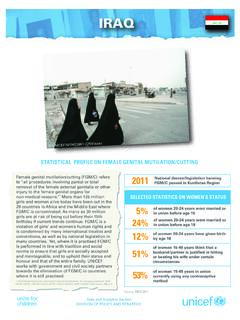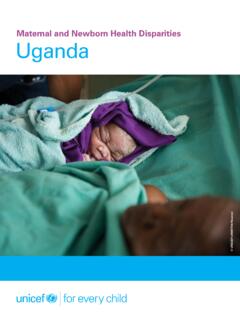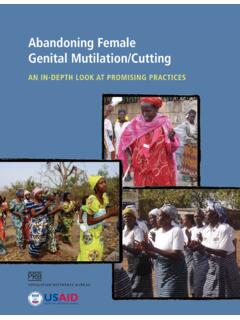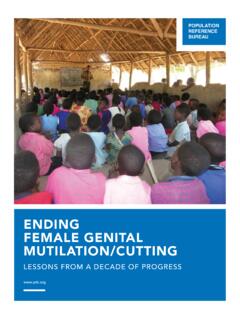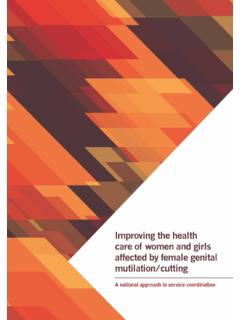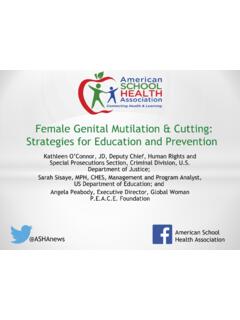Transcription of STATISTICAL PROFILE ON FEMALE GENITAL …
1 STATISTICAL PROFILE ON FEMALE GENITAL mutilation /CUTTINGF emale GENITAL mutilation / cutting (FGM/C) refers to all procedures involving partial or total removal of the FEMALE external genitalia or other injury to the FEMALE GENITAL organs for non-medical reasons. More than 125 million girls and women alive today have been cut in the 29 countries in Africa and the Middle East where FGM/C is concentrated. As many as 30 million girls are at risk of being cut before their 15th birthday if current trends continue. FGM/C is a violation of girls and women s human rights and is condemned by many international treaties and conventions, as well as by national legislation in many countries.
2 Yet, where it is practised FGM/C is performed in line with tradition and social norms to ensure that girls are socially accepted and marriageable, and to uphold their status and honour and that of the entire family. UNICEF works with government and civil society partners towards the elimination of FGM/C in countries where it is still practised. 1. World Health Organization, Eliminating FEMALE GENITAL mutilation : An interagency statement, WHO, UNFPA, UNICEF, UNIFEM, OHCHR, UNHCR, UNECA, UNESCO, UNDP, UNAIDS, WHO, Geneva, 2008, p. 4. 1 SELECTED STATISTICS ON WOMEN S STATUS DIVISION OF POLICY AND STRATEGYG uinea MAURITANIA Source: DHS 2001-01, MICS 2007 and MICS 2011 2 34%14%of women 20-24 years were married or in union before age 15of women 20-24 years were married or in union before age 1819%of women 20-24 years have given birthby age 1838%of women aged 15-49 years old think that a husband/partner is justified in hitting/beating his wife under certain circumstances40%of women 15-49 years make use at leastone type of information media at leastonce a week (newspaper, magazine,television, radio)
3 2005 National decree/legislation banning FGM/C passedData and Analytics Section69 81 57 94 48 0 20 40 60 80 100 Total Rural Urban Poorest Richest 6 14 80 3 93 4 54 68 33 66 49 21 60 83 21 0 20 40 60 80 100 Total Rural Urban No education Primary complete Secondary or higher Poorest Richest Nearly 70 per cent of girls and women in Mauritania have undergone FGM/C with those living in rural areas and from poorer households more likely to experience the practiceMost girls underwent the practice before the age of 5 HOW WIDESPREAD IS THE PRACTICE? WHEN AND HOW IS FGM/C PERFORMED? P15-49 years who have at least one daughter who has had FGM/C, by place of residence and mother's educationPercentage distribution of most recently cut daughters, by daughter's age at cutting Percentage of girls and women aged 15-49 yearswho have had FGM/C, by pr fecturePercentage of girls and women aged 15 to 49 years who have undergone FGM/C, by regionPercentage of girls and women aged 15 to 49 years who have undergone FGM/C, by residence and household wealth quintilePercentage of girls aged 0 to 14 years who have undergone FGM/C (as reported by their mothers)
4 , by residence, mother's education and household wealth quintileAmong daughters of cut girls and women, the percentage of girls aged 0 to 14 years who have undergone FGM/C (as reported by their mothers), by mothers' attitudes about whether the practice should continueDaughters whose mothers think FGM/C should continuePercentage distribution of girls who have undergone FGM/C (as reported by their mothers), by age at which cutting occurred0 20 40 60 80 100 Source for all charts on this page: MICS 2011, unlessotherwise notedPercentage distribution of girls aged 0 to 14 years who have undergone FGM/C (as reported by their mothers), by type of FGM/C performedPercentage distribution of girls aged 0 to 14 years who have undergone FGM/C (as reported by their mothers), according to the type of person/practitioner performing the procedure1081020406080100 HOW WIDESPREAD IS THE PRACTICE?
5 WHEN AND HOW IS FGM/C PERFORMED? Daughters whosemothers areunsureDaughters whose mothers sayit dependsDaughters whosemothers think FGM/C should stop422110-4 years5-9 years10-14 years15+ yearsDon t know/Missing0 20 40 60 80 100 8766 6641 Koranic/non-standard curriculumTraditionalpractitionerHealth personnelDon t know/MissingCut, flesh removedCut, no flesh removed/NickedType not determined/ Not sure/ Don t know10% - 25%26% - 50%51% - 80%Less than 10%Above 80%Source: MICS 2007 Notes: The boundaries and the names shown and the designations used on the map do not imply official endorsement or acceptance by the United Nations. Only categories with 25 or more unweighted cases are presented.
6 Due to rounding, some of the data presented may not add up to 100 per cent. There is no ethnicity or religion data for Mauritania. Prevalence data for girls aged 0 to 14 reflect their current, but not final, FGM/C status since some girls who have not been cut may still be at risk of experiencing the practice once they reach the customary age for cutting . Therefore, the data on prevalence for girls under age 15 is actually an underestimation of the true extent of the practice. Since age at cutting varies among settings, the amount of underestimation also varies and this should be kept in mind when interpreting all FGM/C prevalence data for this age group.
7 Older data are used to report on age at cutting since data from the most recent survey includes some girls aged 0 to 14 years who have not undergone FGM/C but are still at risk of experiencing the practice once they have reached the customary age for cutting . Health personnel includes doctors, nurses, midwives and other health workers; Traditional practitioner includes traditional circumcisers, traditional birth attendants, traditional midwives and other types of traditional practitioners. 19120 20 40 60 80 100 Think FGM/C should continue Think FGM/C should stop Say it depends/are not sure WHAT ARE THE PREVAILING ATTITUDES TOWARDS FGM/C?IS THE PRACTICE OF FGM/C CHANGING?
8 Percentage of girls and women aged 15 to 49 years who have undergone FGM/C, by current agePercentage of boys and men aged 15 to 49 years who have heard about FGM/C, by their attitudes about whether the practice should continueOne in three girls and women think FGM/C is necessary for social acceptance, and one in three think it is necessary for the preservation of virginity Source: DHS 2000-2001 Among girls and women aged 15 to 49 years who have heard about FGM/C, the percentage who cite specific benefits or advantages for a girl to undergo the procedurePercentage of girls and women aged 15 to 49 years who have heard about FGM/C and think the practice should continue, by household wealth quintile, education, residence and ageThere has been no significant generational change in the prevalence of FGM/C in Cameroon.
9 However, adolescent girls are less likely to support continuation of the practice than older women69 There are signs of a small decline in the prevalence of FGM/C over time 41 72 18 52 42 21 50 54 26 42 41 0 20 40 60 80 100 Total Poorest Richest No education Primary complete Secondary or higher Koranic/non-standard curriculum Rural Urban 45-49 years 15-19 years Percentage of girls and women aged 15 to 49 years who have undergone FGM/C, and percentage of girls and women aged 15 to 49 years who have heard about FGM/C and think the practice should continue72695341 MICS 2007 MICS 2011 Prevalence of FGM/C Think FGM/C should continue 0 20 40 60 80 100 DHS 2000-2001716475 76 72 71 67 66 66 0 20 40 60 80 100 45-49 40-44 35-39 30-34 25-29 20-24 15-19 20 40 60 80 100 No benefitsMore sexual pleasure for the manCleanliness/HygieneSocial acceptanceBetter marriage prospectsPreservation of virginityRequired by religionOtherDon t know2119 354312299N/ASource: DHS 2000-2001 Source for all above charts: MICS 2011, unlessotherwise notedNotes: N/A = not available.
10 There are no ethnicity data for Mauritania. Data on women s attitudes cannot be directly compared with men s attitudes since the data source for girls and women is more recent than that for boys and STATISTICAL OVERVIEWMAURITANIA1 2 2 3 5 6 7 9 9 10 11 14 17 21 31 34 37 38 41 41 42 45 49 54 64 65 66 69 73 Benin Togo Ghana Niger Iraq Cameroon Uganda Burkina Faso Kenya C te d'Ivoire Senegal Nigeria Ethiopia Guinea-Bissau Djibouti Chad Mauritania Yemen Sudan Liberia Eritrea Egypt Gambia Somalia Sierra Leone Guinea Mali 1 1 2 4 4 8 13 15 17 24 26 27 27 38 44 50 66 69 74 76 76 88 88 89 89 91 93 96 98 0 20 40 60 80 100 Cameroon Uganda Niger Ghana Togo Iraq Benin Yemen Central African Republic


